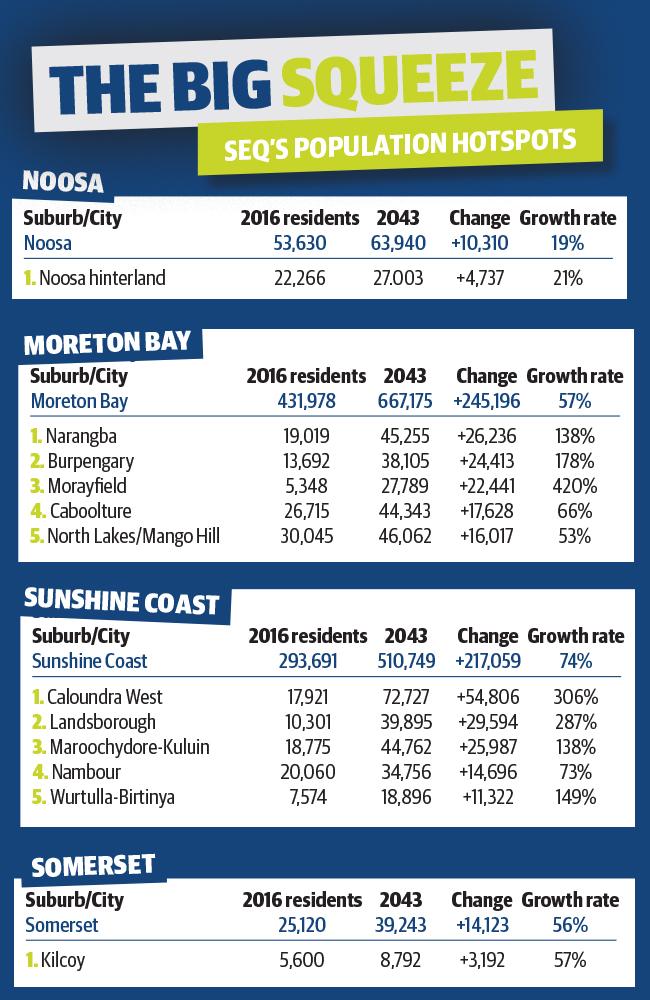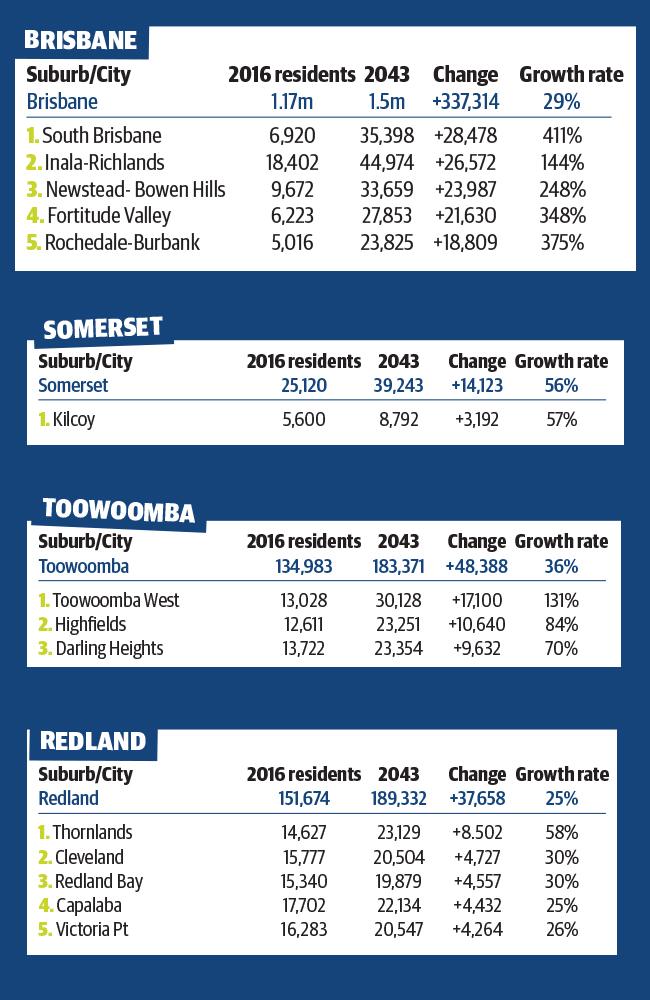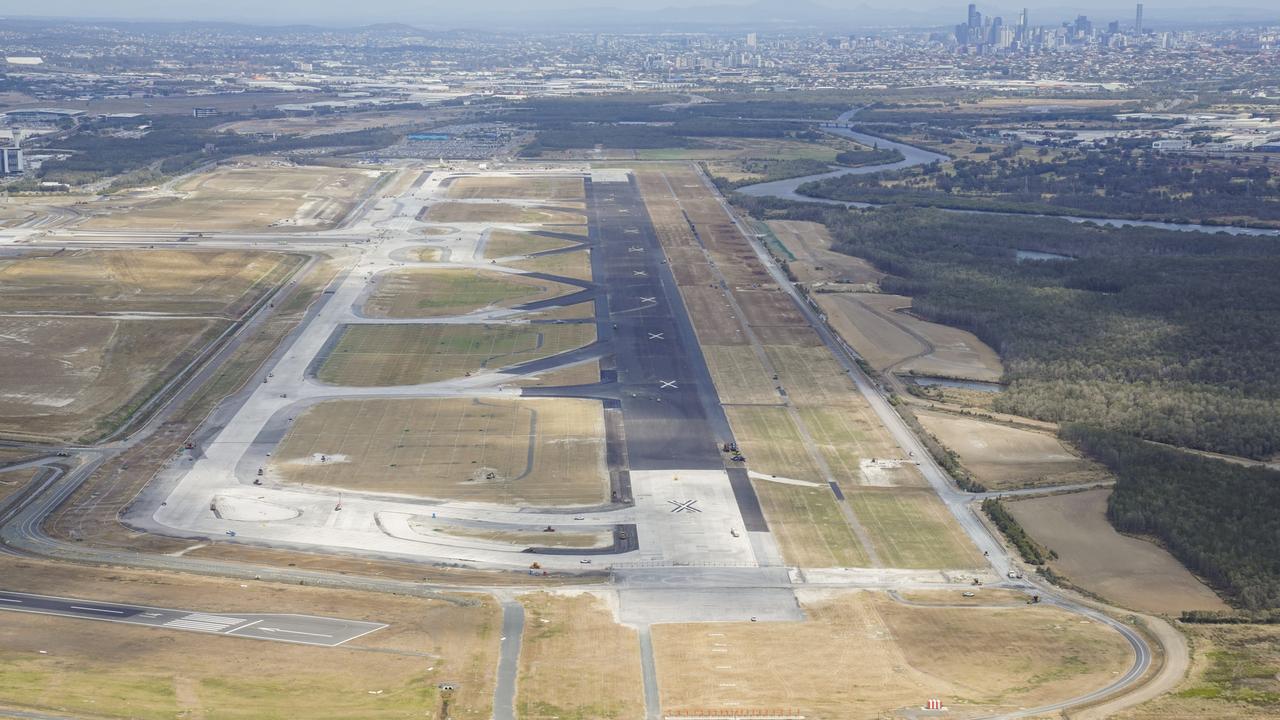Southeast Queensland’s booming population hotspots
SUBURBS will soar skywards and cities will spring out of paddocks as millions of extra people squeeze into the southeast Queensland corner. SEE HOW YOUR SUBURB WILL CHANGE
Future QLD
Don't miss out on the headlines from Future QLD. Followed categories will be added to My News.
SUBURBS will soar skywards and cities spring out of paddocks as millions of extra people squeeze into the southeast corner.
Previously unpublished data from the State Statistician’s Office reveals the enormous extent of the expected explosion in the region’s population hotspots between now and 2043.
Many of the neighbourhoods people now call home will be virtually unrecognisable as planners and councils wrestle with how to balance growth with liveability.
The State Government’s Shaping SEQ regional plan expects 794,000 new dwellings to be built by 2041 — more than half as many again — on top of the existing 1.3 million.
It sets a target of containing 60 per cent of them within the existing urban footprint.
But it is not evenly spread.
In Brisbane, 94 per cent of all new housing development will be within the current urban area, while on the Gold Coast it will be 81 per cent.
CBD OF NEW SUPER-REGION TWICE AS BIG AS BRISBANE
$5bn DEVELOPMENT: BUILD IT AND THEY WILL COME
INFLUX TO SOUTHEAST COULD SEE STATE SPLIT
WHAT SOUTH EAST QUEENSLAND WILL LOOK LIKE IN 2043
Much of it will be concentrated in the inner-city, where previously industrial and commercial suburbs such as South Brisbane and Newstead-Bowen Hills become residential magnets.
Each will add between 20,000 and 30,000 residents, along with Fortitude Valley.
The data has been released as part of The Courier-Mail’s Future SEQ series, which will explore the transport infrastructure opportunities and challenges ahead for the region, before developing an action plan. It will culminate in a major event on October 23.
“People don’t like change but the reality is that change is inevitable in cities,” Brisbane City Council Lord Mayor Graham Quirk said.
The Council is reassuring residents that if they live in suburbs zoned for single homes, they would remain that way, by concentrating development in inner-city areas and transport corridors.
Greater density would be balanced with the purchase of private land to create 200 extra parks over the next 20 years as the council aims to increase green space to 40 per cent of the city land area by 2031.
But even the forecast for Brisbane growth pales beside parts of the Gold Coast.
Southport’s population will almost triple to 83,549. Surfers Paradise will double to 42,134.
The new family-oriented housing area of Coomera will balloon from about 12,500 to 89,164 — bigger than Rockhampton — and adjacent Pimpama will swell from about 6000 people to nearly 34,000.
The latest City Plan allows unlimited building heights in Southport, Surfers Paradise, Broadbeach and Coolangatta, and Mayor Tom Tate said higher density development would be encouraged along the light rail corridor, which is planned to be extended south to Burleigh by 2023. “The days of cutting down the trees and doing greenfield are (almost) over. I call that lazy development,” he said.
The Ripley Valley, south of Ipswich, where a smattering of about 5000 people live, will be home to 150,000, close to the size of Cairns or Toowoomba today. And further west, Rosewood will erupt from about 12,000 to over 100,000.
The Greater Springfield masterplanned city will also have reached its target 115,000 population a decade earlier.
Ipswich City Council administrator Greg Chemello said: “It’s quite remarkable that the population of Ipswich is set to grow to more than 500,000 people in the next 20 years, by far the fastest growth in the region and one of the fastest growing cities in Australia.
“That means we’ll be looking to build more than 100,000 extra houses and 65,000 new jobs.”
In Logan, the Greater Flagstone priority development area will be home to 120,000, and Yarrabilba to another 50,000.
“We know the population is coming and we know where they are going … so we will need all levels of government to be planning ahead. There will be no excuse,” Acting Mayor Cherie Dalley said.
Two of the biggest new housing developments on the Sunshine Coast, expected to house more than 100,000 residents, are Stockland’s Aura development south of Caloundra and on the opposite side of the Bruce Highway, the lesser-known Beerwah East precinct, between the highway and Landsborough. Mayor Mark Jamieson said the big challenge was achieving a good mix.
“We need to make sure we get equilibrium in terms of the population profiles, skilled workers and retirees,” he said.
Moreton Bay Regional Council is focusing its in-fill population growth on rail corridors, with a $20 million incentive scheme to waive infrastructure charges and application fees for developments within 800m of some stations and along the Redcliffe Peninsula line.
“It maximises the available land space … by building upwards, leaving more land available for sports, parks, green spaces and recreation to ensure liveability,” Mayor Allan Sutherland said. “But an enormous amount of leadership and investment would be required to manage the tsunami of growth coming our way.”
Australian Industry Group’s Queensland head Shane Rodgers said the region required “some bigger thinking” to deal with the next surge and avoid past mistakes of failing to keep up with infrastructure.
“Crucially, we need a 50-year population policy, not a four-year infrastructure plan that is constantly at the whim of political change and fighting between different levels of government,” he said.
Planning Institute of Australia president Stephen Smith said an honest conversation with the community was needed. “I think there’s a fear of public backlash and the public is fearful because they don’t fully know what’s going on.”



FAMILY LAPS UP BEST OF BOTH WORLDS

IT consultant Peter Rodrick and his family moved to Upper Coomera, in the Gold Coast’s booming northern corridor, four years ago to have “the best of both worlds’’.
“I work in Brisbane but we love living on the Gold Coast so this area is perfect,” he said.
“I drive a few minutes to the (Coomera) train station and jump on a train to work. At weekends, we get to enjoy all the lifestyle the Coast has to offer.”
The family rent a sprawling five-bedroom home, complete with pool, as they look to buy in the area, after moving from Canberra.
They have two other children Lucas, 21, and Bella, 19.
“You get a lot of bang for your buck in the area so we want to buy something before prices go up.”


